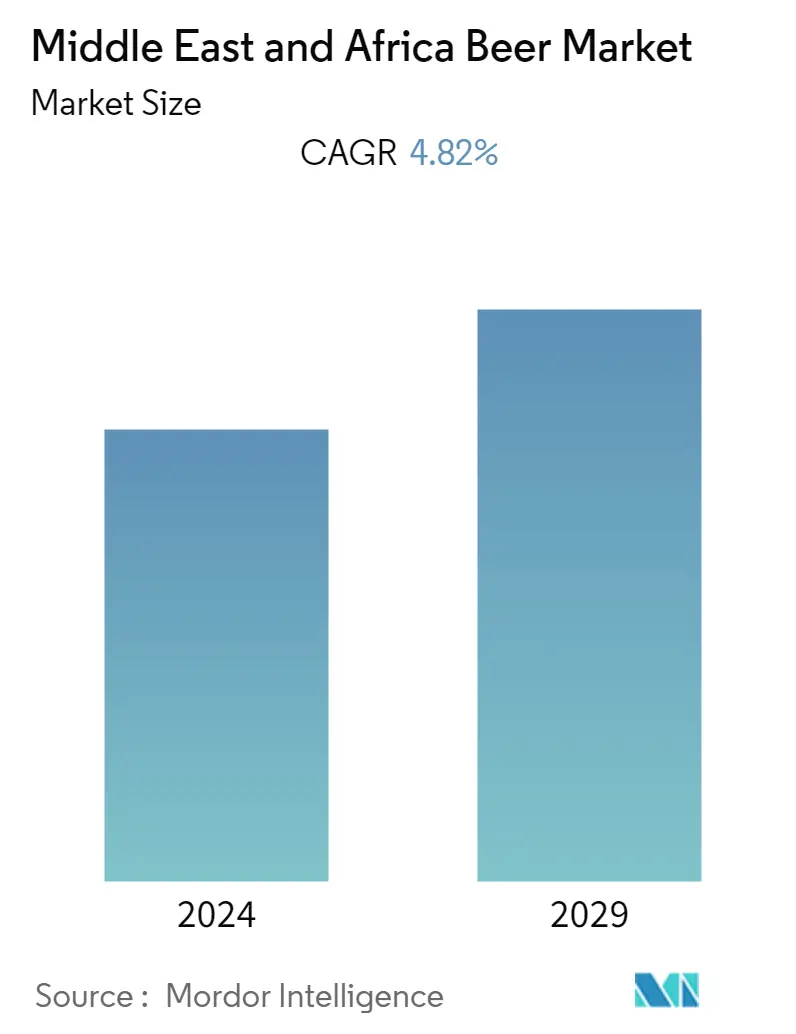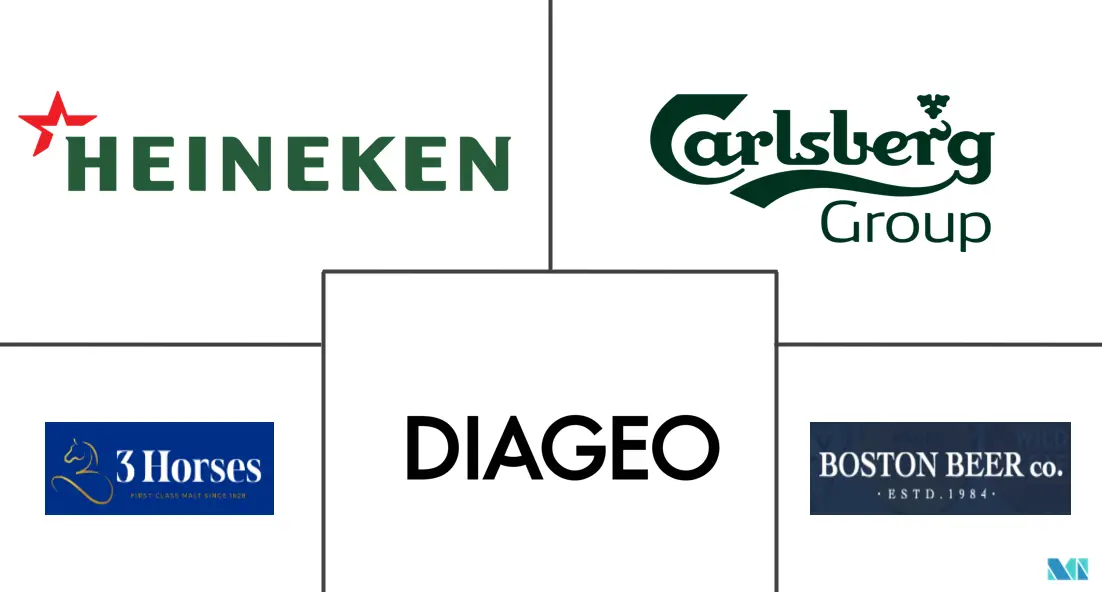Market Size of Middle East & Africa Beer Industry

| Study Period | 2019 - 2029 |
| Base Year For Estimation | 2023 |
| Forecast Data Period | 2024 - 2029 |
| Historical Data Period | 2019 - 2022 |
| CAGR | 4.82 % |
| Market Concentration | Low |
Major Players
*Disclaimer: Major Players sorted in no particular order |
Need a report that reflects how COVID-19 has impacted this market and its growth?
MEA Beer Market Analysis
The Middle East & Africa Beer Market is projected to register a CAGR of 4.82% during the forecast period, 2022-2027.
The Middle East & African beer market may be driven in the medium term by shifting lifestyles, rising alcohol consumption rates, growing urbanization, high disposable incomes, and the youth beer craze. Additionally, the ease of shopping through e-commerce websites is also driving the beer market. Customers across the region prefer doorstep delivery as they consider it a convenient mode of shopping. Hence, the market players are launching doorstep delivery services to cater to the demands of the customers. For instance, in August 2022, African Eastern and MMI introduced a new, legal home delivery service for wines, whiskey, spirits, and beers in Dubai, United Arab Emirates.
Craft beer was a prominent trend in several nations in the region, adding dynamism to the market as a whole with a variety of innovative products. Craft brewers' ales, wheat beers, stouts, and other beverages appeal to beer consumers who are tired of mainstream lagers or who are brand new to the beer industry. Craft beer satisfies the craving for something unique, contributes to the premiumization and sophistication of beer, and provides producers with higher profit margins than the widely available mid-priced lagers.
COVID-19 caused a rise in the cost of both domestically produced and imported beer across the region. The supply chain disruption, which raised the price of raw materials and the transportation of finished goods, was to blame for the price rise. Raw materials were also scarce due to the regional production halt and labor constraints. However, the business has expanded recently, as consumers increasingly favored drinking at home as bars, taverns, and restaurants closed.
MEA Beer Industry Segmentation
Beer is an alcoholic drink made from yeast-fermented malt and flavored with hops. The Middle East & Africa Beer Market is segmented by type, distribution channel, and by geography. By product type, the market is segmented into lager, craft, and other product types. By distribution channel, the market is segmented into on-trade and off-trade channels which is further subdivided into supermarket/hypermarkets, specialty stores, online retailers, and other distribution channels. In terms of geography, the report covers the United Arab Emirates, South Africa, and the Rest of the Middle East & Africa. The report offers market size and forecasts in value (USD million) for the above segments.
| By Product Type | |
| Lager | |
| Ale | |
| Other Product Types |
| By Category | |
| Regular Beer | |
| Premium Beer |
| By Distribution | |
| On-Trade Channels | |
| Off-Trade Channels |
| Geography | |
| United Arab Emirates | |
| South Africa | |
| Rest of Middle-East and Africa |
Middle East & Africa Beer Market Size Summary
The Middle East & Africa beer market is experiencing a dynamic transformation, driven by evolving consumer lifestyles, increased urbanization, and a growing youth demographic with a penchant for beer. The convenience of e-commerce and doorstep delivery services has further fueled market growth, with companies like African Eastern and MMI expanding their offerings in regions such as Dubai. The craft beer movement has also gained significant traction, offering consumers a diverse range of innovative products that cater to those seeking alternatives to mainstream lagers. This trend not only enhances the premiumization of beer but also provides brewers with higher profit margins. Despite challenges such as supply chain disruptions and rising costs due to the COVID-19 pandemic, the market has seen a shift towards home consumption, with consumers increasingly opting for at-home drinking experiences.
The market is characterized by a fragmented landscape with both regional and international players vying for market share. Key factors propelling growth include the increasing number of breweries, rising demand for low-alcohol and no-alcohol beverages, and the introduction of innovative products. The African region holds a significant share of the market, with countries like South Africa leading in consumption. The popularity of craft beer presents numerous opportunities for brewers, with over 200 craft breweries reported in South Africa alone. Major players such as Heineken N.V., Diageo PLC, and Carlsberg Group are actively engaging in strategies like product innovations and acquisitions to expand their presence. The market's growth is further supported by initiatives such as the launch of new products and the establishment of unique venues, enhancing the overall beer consumption experience in the region.
Middle East & Africa Beer Market Size - Table of Contents
-
1. MARKET DYNAMICS
-
1.1 Market Drivers
-
1.2 Market Restraints
-
1.3 Porter's 5 Forces Analysis
-
1.3.1 Threat of New Entrants
-
1.3.2 Bargaining Power of Buyers/Consumers
-
1.3.3 Bargaining Power of Suppliers
-
1.3.4 Threat of Substitute Products
-
1.3.5 Intensity of Competitive Rivalry
-
-
-
2. MARKET SEGMENTATION
-
2.1 By Product Type
-
2.1.1 Lager
-
2.1.2 Ale
-
2.1.3 Other Product Types
-
-
2.2 By Category
-
2.2.1 Regular Beer
-
2.2.2 Premium Beer
-
-
2.3 By Distribution
-
2.3.1 On-Trade Channels
-
2.3.2 Off-Trade Channels
-
-
2.4 Geography
-
2.4.1 United Arab Emirates
-
2.4.2 South Africa
-
2.4.3 Rest of Middle-East and Africa
-
-
Middle East & Africa Beer Market Size FAQs
What is the current Middle East & Africa Beer Market size?
The Middle East & Africa Beer Market is projected to register a CAGR of 4.82% during the forecast period (2024-2029)
Who are the key players in Middle East & Africa Beer Market?
Heineken N.V., Diageo PLC, Three Horses Beer, Carlsberg Group and Boston Beer Company are the major companies operating in the Middle East & Africa Beer Market.

